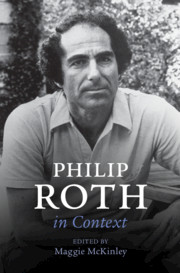Book contents
- Philip Roth in Context
- Philip Roth in Context
- Copyright page
- Contents
- Notes on Contributors
- A Note on References and Abbreviations
- Introduction
- Part I Life and Literary Contexts
- Chapter 1 Life
- Chapter 2 Literary Influences
- Chapter 3 Literary Conversations
- Chapter 4 Roth’s Comic Seriousness
- Chapter 5 Writing About Writing
- Part II Critical Contexts
- Part III Geographical Contexts
- Part IV Theoretical Contexts
- Part V Jewish American Identity
- Part VI Gender and Sexuality
- Part VII Political Contexts
- Part VIII Roth’s Legacy
- Primary Bibliography
- Selected Secondary Bibliography
- Index
Chapter 4 - Roth’s Comic Seriousness
from Part I - Life and Literary Contexts
Published online by Cambridge University Press: 15 July 2021
- Philip Roth in Context
- Philip Roth in Context
- Copyright page
- Contents
- Notes on Contributors
- A Note on References and Abbreviations
- Introduction
- Part I Life and Literary Contexts
- Chapter 1 Life
- Chapter 2 Literary Influences
- Chapter 3 Literary Conversations
- Chapter 4 Roth’s Comic Seriousness
- Chapter 5 Writing About Writing
- Part II Critical Contexts
- Part III Geographical Contexts
- Part IV Theoretical Contexts
- Part V Jewish American Identity
- Part VI Gender and Sexuality
- Part VII Political Contexts
- Part VIII Roth’s Legacy
- Primary Bibliography
- Selected Secondary Bibliography
- Index
Summary
“Sheer Playfulness and Deadly Seriousness are my closest friends,” Philip Roth once said. This wry comment perfectly encapsulates the characteristic use of comedy and irony in his work; though his writing can be situated within a larger history of comic authors, his tragicomic style is immediately identifiable as his own, and has become part of his literary legacy. This chapter discusses Roth’s unique brand of humor, defining its iterations and tracing the different ways it is employed in some of his most notable works.
- Type
- Chapter
- Information
- Philip Roth in Context , pp. 37 - 47Publisher: Cambridge University PressPrint publication year: 2021

